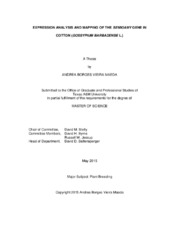| dc.description.abstract | Several naturally occurring apomicts rely on various forms of semigamous reproduction, where female and male nuclei fail to fuse after fertilization. Heritably high frequencies of haploids among monoembryonic seed were reported in 1963 in the cotton cultivar 'Pima S-1’ (Gossypium barbadense L.). Later, the doubled haploid line '57-4' derived from ‘Pima S-1’ was developed. The combined production of haploids, maternal/paternal chimeras and zygotic progeny subsequently led to the hypothesis of reproduction by semigamy. Incomplete expression, gene dosage relationships and patterns of inheritance led to the hypothesis of control by a single, incompletely dominant gene, Semigamy (Se). The gene has a number of practical uses in breeding and science that would likely benefit from additional knowledge about the gene’s location, mode of gene action, penetrance and expression. Our lab has studied the cytology, expression and chromosomal localization of Semigamy, but some results have been incongruous. Here, I re-map Se using new methods, markers and germplasm, and compare findings to previous results; I also characterize maternal versus paternal Se expression. Genetically marked reciprocal crosses between Semigamy homozygous and heterozygous plants allowed the tracking of allelic inheritance in maternal and paternal haploid sectors in chimeric progeny. SNP markers were developed for the Semigamy region, and then used for genotyping sectors, linkage analysis, expression analysis and marker-assisted backcrossing.
Genotypes of haploid sectors and backcross individuals confirmed the SNP selection procedures and differentiated between previous Se mapping results. Crosses with female versus male Sese heterozygotes demonstrated markedly different effects on reproduction. Transmission of Se-linked SNPs from heterozygous females to normal progeny was random (1:1), whereas all haploid sectors had Gb (Se) alleles, indicating that semigamy requires megagametophytic expression of the Se locus (or lack thereof). Se-linked SNPs of haploid sectors from heterozygous males, on the other hand, occurred in ~3:1 distribution of Gb and Gh allele. The differences between male and female results was statistically significant (p < 0.05), but additional studies are needed to differentiate among possible causes for those differences. | en |


